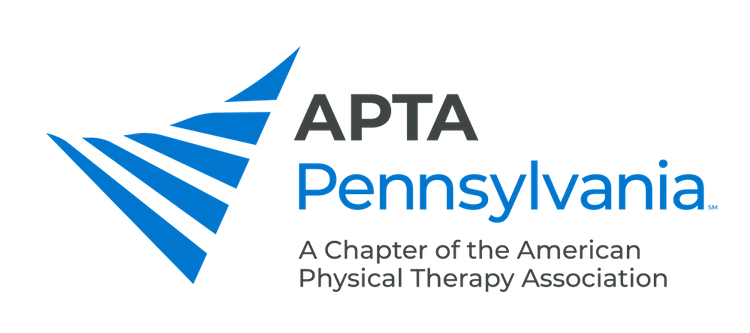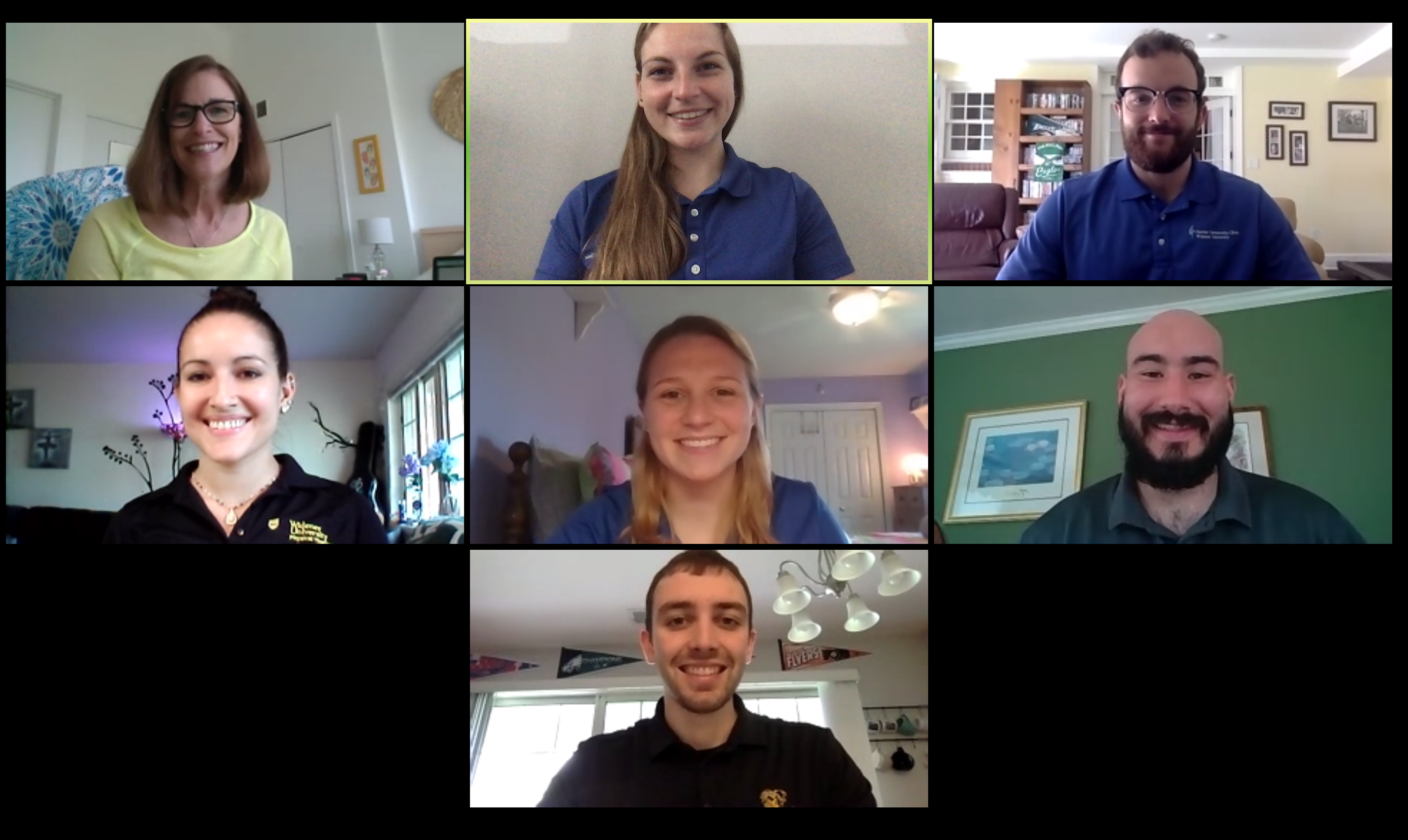 COVID-19 Stories"Surviving the COVID Pandemic: My Outpatient Clinic's Response and My Personal Journey" by Jamie Del Palazzo, PT, DPT I’m an outpatient physical therapist working for a private practice in the Philadelphia region. When COVID-19 cases began appearing in SE Pennsylvania in mid-March, my company made the decision to close for 2 weeks to develop policies and procedures to facilitate a safe reopening process. There was immense change during that 2 week period as payers began allowing for PT’s to provide telehealth services.I maintained my caseload with courtesy phone calls during the closure. When my clinic reopened, I initially was treating the bulk of my caseload via telehealth. For those few patients I saw in the clinic, we took every precaution to mitigate the risk to patients and employees. Now as we enter into July, I am seeing the majority of my caseload in the clinic and I have one patient receiving treatment via telehealth. We continue to clean, wear PPE, limit the number of patients in clinic, and maintain social distancing for our patients and therapists. The biggest challenge to me during this time has been managing my patients when their referring physicians are foregoing follow-ups or only opting to see their patients via telehealth. As the provider who has the opportunity to see the patient for a face to face encounter, I have had to practice at the top of my license to ensure patients are getting the care they need and are referred appropriately. I’ve been taking more vital signs, and calling and emailing physicians more than I ever have before when I note changes in patient status. Working during the pandemic as an essential worker to ensure my patients are getting the care they need has been rewarding. Outpatient physical therapy has had an important role to play during this time. I have grown as a clinician from this experience, and I also make sure that I make the time for self care. Through the worst of the pandemic and during shelter in place orders, I took time to journal, meditate using the Headspace app subscription that was offered free to healthcare providers, and I made time for some type of movement daily even if it was just a walk with the dogs to get outside. Forming these habits helped me stay centered and help me maintain perspective even on those days when I was anxious and worried. It was and continues to be important to bring my best self daily to the patients I am serving.
“Resources for Clinical Instructors during COVID-19” I am an outpatient Physical Therapist working for HARTZ Physical Therapy in Lancaster, PA. During the COVID-19 pandemic I served as a clinical instructor for a 3rd year DPT student. As clinical educators, our actions in this time provides a critical demonstration for how to quickly adapt and work through global health crises. DPT students are currently facing very unpredictable and anxious times in their academia, including cancelled or delayed clinical rotations, abrupt transition to online education, and graduating into a time of economic uncertainty. We need to ask ourselves, how can we best support our DPT students for their professional future and provide them with a clinical environment to facilitate learning during COVID-19? First and foremost, communication is essential during this time. It is pertinent to stay abreast of the impact of COVID-19 on our profession and students and relay that information to them. The PPTA and CAPTE have done excellent jobs of posting concise information on all legislative changes. I recommend to always take a few minutes to “check in” with the students at the beginning of each day to ensure they are doing well, and to educate them on all pertinent updates. At the start of clinical rotations, students should be fully prepared for the unique challenges of our current situation, including changes to the treatment model, schedule changes, and expectations going forward. It is imperative to review with them best practices for pathogen control, including but not limited to universal precautions, hand hygiene, isolation, equipment cleaning, and correct use of PPE. COVID-19 has undoubtedly changed our patient care model and as a result, we have been forced to consider alternative teaching-learning experiences. The following are potential strategies:
In this challenging and uncertain time, it is important for all of us to work together and share resources to prepare students for their upcoming entry into practice. Let us all embrace the teaching and learning experiences that occur and do our very best to keep clinical healthcare education moving in a positive direction.
"Utilization of Home Exercise Programs (HEPs) for Patient Resource and Guidance During Telehealth Transition" The current coronavirus pandemic has PTs, PTAs, and students transitioning to telehealth services, as some patients are unable to attend traditional therapy. Utilizing any resources that help empower our patients to continue their journey of recovery and strengthening on their own is essential. The current COVID crisis has resulted in many students being pulled from clinical experiences, or prevented from even starting their clinical rotations. It also resulted in the shut down of the Widener University pro bono clinic. Our program has been using two free HEP services to help give our patients guidance and resources during these times – “Hep2Go” and “HepBuilder”. Hep2Go has been a great resource in the past for patients who have a language barrier, as it includes pictures and is easy to translate and modify for the specific patients needs. HepBuilder has been a new addition as our pro bono clinic switched to telehealth. HepBuilder not only provides instructions and pictures for exercises, but includes video links for each exercise so that the patient can see how correct form is supposed to look. We’ve found success in this platform for increasing patient compliance with HEPs while at home, and guiding telehealth sessions. By sending an exercise program with videos before the session, the patient is able to be familiar with the general form of the exercise. This allows sessions to flow smoother. The therapist can spend more time on exercises that the patient is having difficulty performing with correct form, while maybe only doing one set of an exercise that the patient is comfortable doing or has done before. Instead of one HEP that only has a few exercises, we have been able to expand using these services to provide guidance and different exercises to work on throughout the week. This allows the programs to not get repetitive and boring and focuses on the main goals of the physical therapy team. DISCLAIMER: PPTA has no financial interest to disclose in this story. The reference to "Hep2Go" and "HepBuilder" is for informational purposes only. PPTA does not endorse particular products. Therapists should exercise professional judgment when recommending exercises from these products to patients. "Take Care of Yourself During the Coronavirus Crisis – GET MOVING!" by Harnoor Singh, SPT
My name is Harnoor, and I am a physical therapy student at the University of the Sciences. In our classes, we learn that physical therapy is founded in the “movement system.” We also learn that our profession has a role in promoting "wellness." That led me to think about how I could combine my role as a physical therapy student with my passion for movement and dance. The idea that I came up with was to create a “movement challenge” that would encourage me, other students, therapists, and even the public to stay healthy through movement.
Earlier this year, even before the COVID-19 crisis, I started a social media challenge of posting a video of myself showing new, innovative, and fun ways to move and enjoy our bodies. My goal was to post every day for 365 days. When COVID-19 began to unravel, I am excited to say that I personally have continuously engaged in this movement practice. My strength has really been building and many people have been inspired to move with me daily by watching my videos. A part of this experience has really let me feel that the power of movement can bring joy to people in a time of crisis. I encourage you to join my challenge and view all my posts on Instagram at: Movementwithnoor. Thank you for the privilege to share my story and my videos with you!
Harnoor is also a yoga instructor, Acroyoga instructor, and hip hop dance instructor. Click below to view some of Harnoor's videos:
(In picture: (top row - from left) Jill Black (program director), Stephanie Saylor and Josh Hammaker.
(middle - from left) Gabrielle Crespo, Alyssa Myers and John Nellett. | (bottom) John Vizzini.) "Widener Student Leaders: Launching Telehealth for a Pro Bono Clinic"
by Stephanie Saylor, SPT Widener University’s DPT and OTD students run a pro bono clinic, the Chester Community Clinic, providing services to underinsured and uninsured members of our community. During the time of the COVID-19 crisis, we had 29 active patients receiving physical therapy and/or occupational therapy services with some also receiving services from our psychology and social work graduate student interns. When the university had to close campus due to COVID-19, many of our patients were unsure of what was next. We made sure each patient had access to an HEP that they understood and the equipment they needed; but other than this, the future was uncertain.
Our class, the class of 2021, completed our semester virtually and anticipated an April 13 start date for our first full-time clinical experience. We soon realized that the start of that experience would be delayed. One of our faculty members presented the idea that perhaps we might explore launching pro bono telehealth for our patients that were home without our services for three weeks now. Seven of us took her up on that challenge and we started exploring the idea. We began by researching the State regulations and license requirements for the students and our supervisors. We researched various video platforms. We began editing our current documents to make them Telehealth friendly. This included transforming intake forms to fillable PDFs, creating a consent form, modifying our appointment confirmation methods, and creating a new process for document storage. We also reached out to each of our four professions (PT, OT, Psych, SW) to see if they were all able to participate in this approach. Once all professions were contacted, we began moving forward.
"Acute Care Response to COVID-19"
by Sarah Dunn, PT
I am an acute care physical therapist. I work for Good Shepherd Penn Partners at Penn Presbyterian Medical Center in Philadelphia. In preparation for treating patients who have COVID-19, a small team of my colleagues created a planning committee. We utilized the resources from the APTA Academy of Acute Care Physical Therapy including the webinar series as well as the APTA endorsed guidelines from Australia. From these resources, we created a plan for how to best prepare, as a department, for the anticipated surge of patients with COVID-19. This included altering schedules, recruiting outpatient therapists to cross train to acute care, educating staff on the disease process, and creating a contact-free screening tool. Currently, Penn Presbyterian has a large number of patients who have COVID-19. I am one of the therapists who are on the volunteer COVID-19 therapy treatment team. We have found that there are a lot of caveats working through this pandemic. Specifically, the medical and physical trajectory for these patients, need for supplemental oxygen and very difficult discharge situations. In our region, there are no acute rehab hospitals who will accept a patient with COVID-19. The options for SNF are limited and even more limited for people who also require dialysis.
I would like to take a minute to highlight a few patients who have made an extraordinary recovery thanks to the expertise, teamwork and support of everyone at Penn Presbyterian. To date, we have 6 patients who have, or will once discharged, progress directly to home after weaning off the ventilator (some have a trach and a few required ECMO), bypassing the need for inpatient rehab. Typically someone who has undergone such extraordinary medical support, up to 4 weeks in the hospital, requires a much longer recovery trajectory. I am extremely proud of the entire Presbyterian Rehab team and the impact we are making to support Philadelphia during the COVID-19 pandemic. "Physical Therapy Success Using Telehealth" I am the owner of Willow Grove and Hatboro Physical Therapy. Prior to COVID-19 both of these offices were bustling with patients suffering from dizziness, balance and orthopedic pain issues. Suddenly with the arrival of COVID-19, our business took a deep dive. We are now using telehealth for a few of our patients, and for the majority of our patients who are seniors and covered by Medicare, we are using telephone communication and e-visits.
It has been a challenge to learn telehealth essentially over night, but we are getting better with practice, and are doing this because we care about our patients. There was a learning curve for us and for our patients as well. We had to educate our patients to the benefits of this valuable service and, for those who are appropriate candidates, let them realize that it is the safest mode under the current crisis. My favorite telehealth success story is a patient who had a fall with head trauma. He was struggling with vertigo, unsteadiness and additional falls. He told me that his one visit with me through telehealth was more beneficial than the weeks of therapy he received at another outpatient clinic. He reports > 50% progress in his dizziness reduction in just a few sessions and has not had any falls since starting telehealth with me. This made me realize that is possible to provide a significant value to our patients even though it is not through a face to face visit. My hope is that Medicare will begin paying for telehealth services. Providing services with telehealth can save lives for seniors. For my patient, the ability of continuing physical therapy care using telehealth has led to a decrease in his fall risk. For a senior, this is essential, as falling is a leading cause of death for this population. I am hopeful that my own company will be able to increase our use of telehealth visits to reach patients during this crisis and beyond. PPTA is calling for PTs, PTAs, and students working on the frontlines of the COVID-19 pandemic to share information about their experiences. Photos are welcome! Examples of experiences to share suggested by PPTA include:
Have a COVID story to share with us? Share it here!
|


